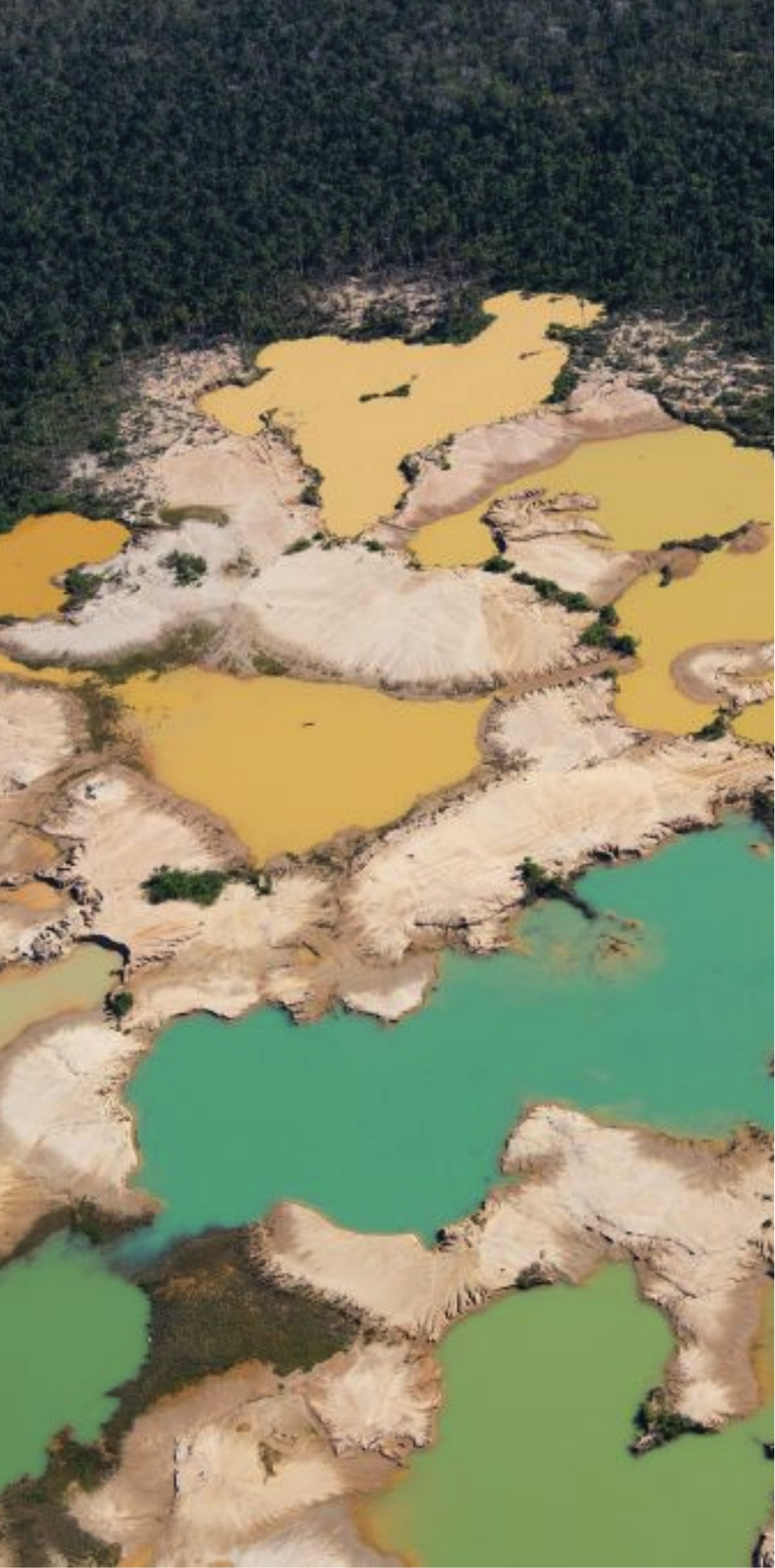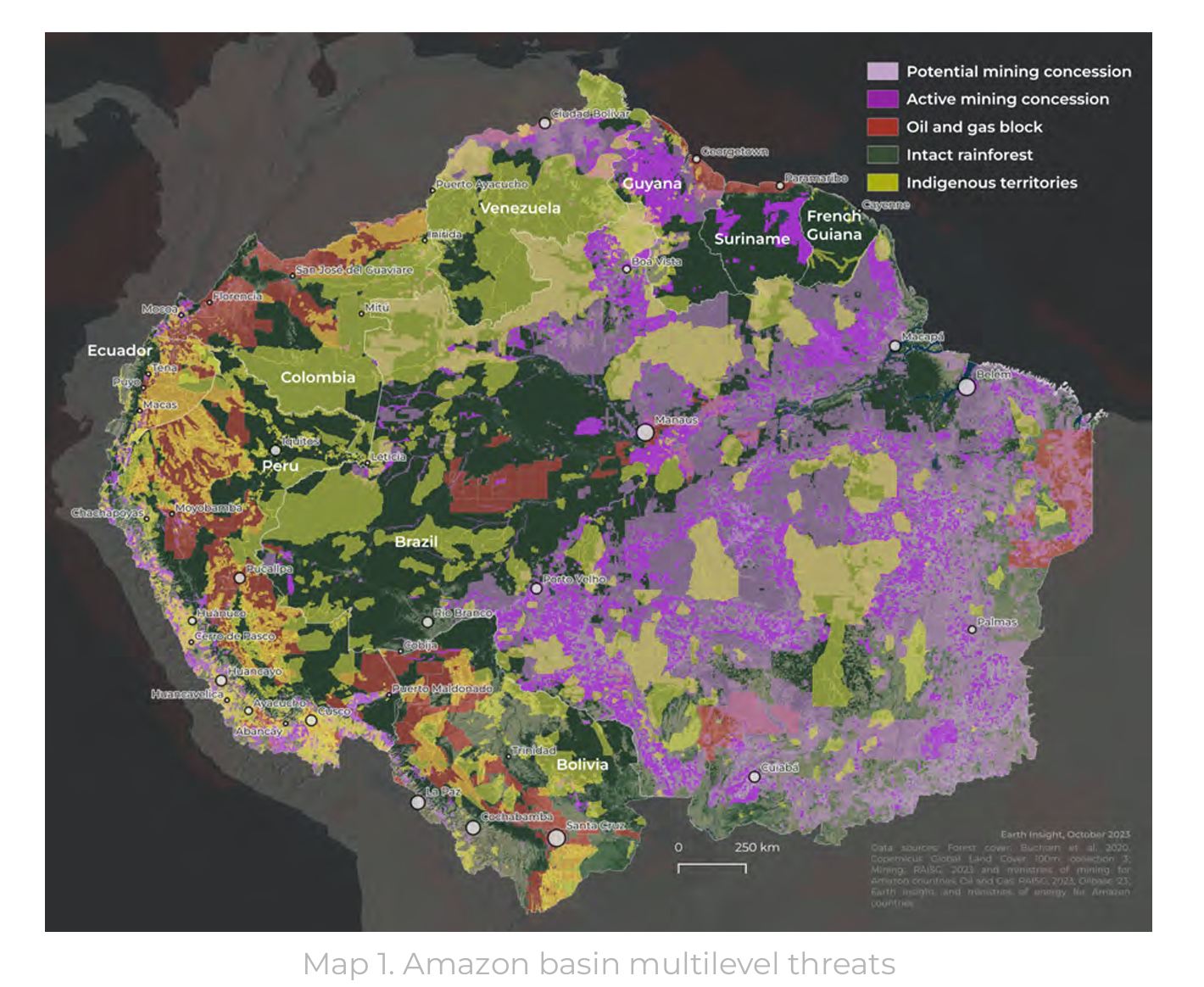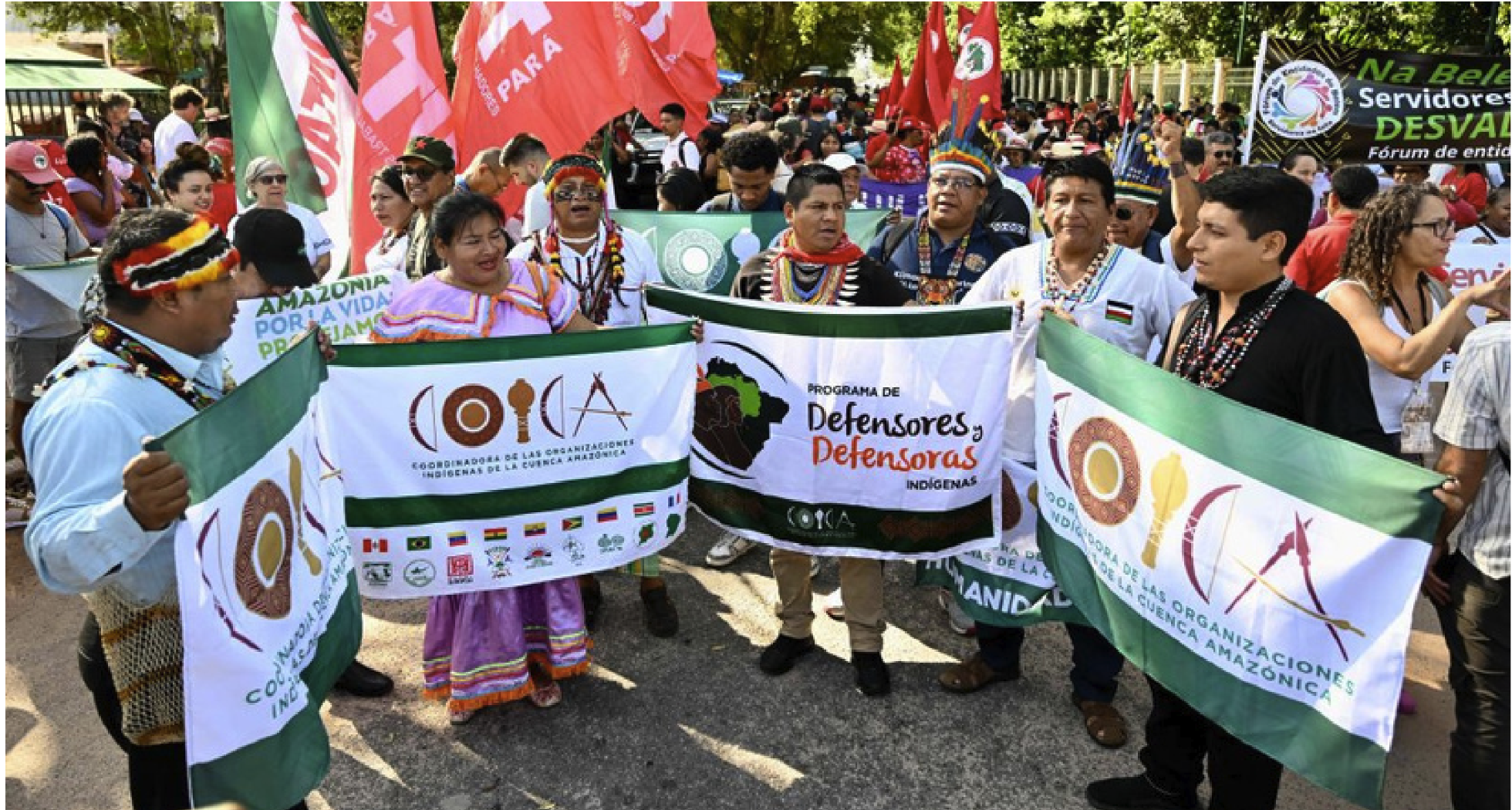
Briefing Note: Three Basins Multi Threats to the Amazon
Introduction:
Fossil fuel and mining expansion in the Amazon is an urgent threat that will harm climate stability, the integrity of one of the world’s most vital ecosystems, and the Indigenous and local communities who call this region home.
The vital forests and riverine ecosystems of the Amazon basin are natural and cultural wonders that are critical for the maintenance of biodiversity and climate stability. Their preservation is essential for Indigenous and local communities who call them home and for the future of humanity. The first cut is the deepest, and the expansion of fossil fuel, mining and other industrial activities have the potential to initiate a cascade of deforestation and forest degradation that follow. Without a halt to extractive activities in intact areas — and adequate protection and enforcement, the remaining forests and the Indigenous and local communities that depend on them will continue to be severely impacted. Tropical forest basins risk systemic ecosystem breakdown, and as climates warm, feedback loops get triggered, and entire canopies die off. Amazonia is already in the midst of a tipping point crisis that threatens the rainforests’ very existence, and it is imperative that 80% of the forests and ecosystem be protected.

An aerial view over a chemically deforested area of the Amazon jungle caused by illegal mining activities in the river basin of the Madre de Dios region in southeast Peru in 2019.
Image credit: Cris Bouroncle / AFP via Getty Images]
Imminent threats: Key facts
Fossil fuel and mining threats across the Amazon, Congo and Borneo-Mekong Southeast Asian basins
New mapping and analysis shows that:
• Nearly 20% or one fifth of intact tropical forests in the three basins are now in active and potential oil and gas concessions.
• Nearly 25% or a quarter of intact tropical forests in the Amazon and Congo basins are now in active or potential mining concessions.
• In Indonesia nearly half of all nickel concessions, nickel being a major energy transition metal for transportation electrification, overlap with natural forests.
• Over 200 million people, including a significant proportion of Indigenous and local communities, or about 20% or one-fifth of the population in the three basin regions, live within oil and gas blocks.
Oil and gas expansion threats in the Amazon basin:
- An estimated 65 million hectares, or nearly 13% of undisturbed Tropical Moist Forests (an area nearly twice the size of Poland) overlap with oil and gas production and exploration blocks.
- Over 500 distinct Indigenous nationalities call the Amazon Basin home, and more than 31 million hectares of Indigenous Territories are now in oil and gas production and exploration blocks.
- More than 13,000 populated places —including villages, towns, etc. — representing nearly 14 million people, or more than 23% of populated places in Amazonia, now live in oil and gas production and exploration blocks.
Mining expansion threats in the Amazon basin:
- Nearly 170 million hectares, or more than 33% of undisturbed Tropical Moist Forests, overlap with active (~71m ha) and potential (~99m ha) mining concessions.5
- More than 70 million hectares of Indigenous Territories overlap with active (~10m ha) and potential (~60m ha) mining concessions.6
- In an extreme threat scenario, more than 16,000 populated places (villages, communities, towns, etc.) and 27 million people are located in active and inactive mining concessions.

Pervasive disappearance of tropical moist forest across the world
An analysis of Landsat data from 1990-2019 found 218.7 million hectares of tropical moist forest disappeared, with a further 106.5 million hectares in a degraded state. It estimated that at least 45.4% of recent degradation will likely lead to deforestation in less than ten years. Global tropical primary forest loss in 2022 totaled 4.1 million hectares, the equivalent of 11 football fields of forest disappearing every minute.
In the Amazon Basin, some 26% of its area show signs of deforestation and high degradation; 20% have been irreversibly converted; and 6% are highly degraded. It is projected that at least 27% of intact rainforests in the Congo Basin present in 2020 face existential threats by 2050, if the rate of deforestation and forest degradation continues. Southeast Asia has lost forest area larger than Germany – 376,000 km, or nearly one-sixth of its forests, with mounting threats from fossil fuel, mining, agribusiness, forestry and other industrial expansion.

Indigenous people from Amazon countries and members of social movements take part in the March of the Peoples of the Earth for the Amazon in Belém, Para State, Brazil, on August 8, 2023 for the two-day meeting of the Amazon Cooperation Treaty Organization (ACTO).
Image credit: Evaristo Sa / AFP via Getty Images
Protecting forests, advancing Indigenous and community rights, and averting tipping points:
Put simply, primary and intact forests must be preserved now before it is too late and the life-sustaining forest ecosystems of the three basins pass irreversible tipping points and further exacerbate the climate crisis.
The multitude of cascading industrial pressures and future threats explored in this briefing note reinforce the need for new, bold policies and financial mechanisms that are critical for global climate stability and to safeguard the forests of the three basins and the Indigenous and local communities who call them home. In a statement issued by a wide range of Indigenous, regional, and frontline organizations, heads of state from the three basins are being called upon to commit to the following:
- Scale up rights-based on legal protection, demarcation and recognition of forest communities’ lands and territories, as a prerequisite to more effective forest protection.
- Uphold communities’ right to fully and effectively participate in decision making on any developments planned in these areas; respecting Indigenous peoples' right to free, prior and informed consent, as well as securing the protection of those living in voluntary isolation.
- Empower and protect Indigenous peoples and other frontline environmental and human rights defenders by enhancing access to justice and providing strong legal protection for them.
- Halt and reverse loss and degradation of all natural ecosystems from large-scale agriculture, mining, extractives and other industries, such as through a global moratorium on industrial activities in primary forests as well as priority forests and through provision of legal protections for remaining natural forests, including in concession areas.
- Accelerate true, low-carbon development in tropical forest countries through a just energy transition, protecting natural forests and the rights and food sovereignty of local communities and Indigenous peoples.
Adopt time-bound and measurable goals towards these objectives, for transparency and accountability.
Solutions
Addressing sovereign debt: A problematic driver and a powerful solution
Sovereign debt has traditionally been a driver for exploitation of natural resources, disrupting ecosystems and hindering sustainable development. There are high debt numbers in high biocultural diverse regions such as in the Congo basin reaching approximately 40 billion US dollars.
Debt distress needs to be addressed through financial mechanisms, such as debt-for nature swamps, allowing for portions of debt to be forgiven, in return for making commitments to invest in the preservation of biodiversity. Conditioned debt forgiveness can leverage tens of billions in debt repayments as a mechanism to advance protection for some of the world’s most intact and vulnerable ecosystems. With international momentum building for a transformation of the global financial system to support nature protection, there is a critical window in time to leverage existing financial resources in play in the form of debt as a tool for keeping fossil fuels in the ground and advancing expanded protection for nature and the rights of Indigenous peoples and local communities.
Regional and global awareness and momentum is building; and bold action is critical. A range of solutions and frameworks are referenced below that embody the need for both measured and accelerated action:
- The Belem Declaration, if sufficient and timely action is taken, can help avert the tipping point crisis that the Amazon basin is facing.
- A moratorium on all industrial activity in primary and priority forests until 2050 in order to safeguard critical ecosystems and allow time and space to develop appropriate financial system innovations, including adequate funding and payments for ecosystem services, debt relief, redirecting subsidies away from extractive industries, and to develop the legal mechanisms that support primary forest preservation and Indigenous co-management and restoration.
- Expansion of global Indigenous land tenure, access and resource rights, direct funding for co-management, and the requirement of Free, Prior, and Informed Consent (FPIC)
- Global financial architecture reforms that scale up financial resources towards climate action and the Sustainable Development Goals as uplifted by the Bridgetown Initiative
- The Amazonia for Life: 80% by 2025 Declaration from Amazonizan Indigenous federations
- New debt for Climate and Biodiversity commitments from International Financial Institutions, such as the IMF, large debt-holding nations like China, and other debt holders in the private sector
- New frameworks for action including the 10-Point Plan for Financing Biodiversity
- Increased country-level commitments to the principles of the Beyond Oil and Gas Alliance and widespread commitments to the Fossil Fuel Non-Proliferation Treaty
- Unlocking the vast potential in renewables and scaling up direct support to forest communities and other frontline forest defenders.
Additional Data
Several recent reports underscore the global need to end oil and gas expansion – especially in these and other critical forest basins and ecosystems:
- Three Basins Threat Report: Fossil Fuel, Mining, and Industrial Expansion Threats to Forests and Communities
- Crisis Point: Oil and Gas Expansion Threats to Amazon and Congo Basin Tropical Forests and Communities
- Amazonia Against the Clock: a Regional Assessment on Where and How to Protect 80% by 2025
- Fuelling Failure: How coal, oil and gas sabotage all seventeen Sustainable Development Goals
- BankTrack’s Dodgy Deals can be found here. In particular see profiles on Petroperú.
- RAISG and the Amazonia Under Pressure series
- Amazonia Against the Clock published by the Amazonia for Life: 80% by 2025 coalition.
- The Exit Amazon Oil and Gas Platform can be found here

